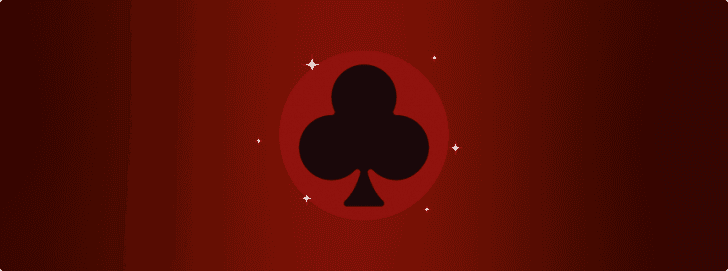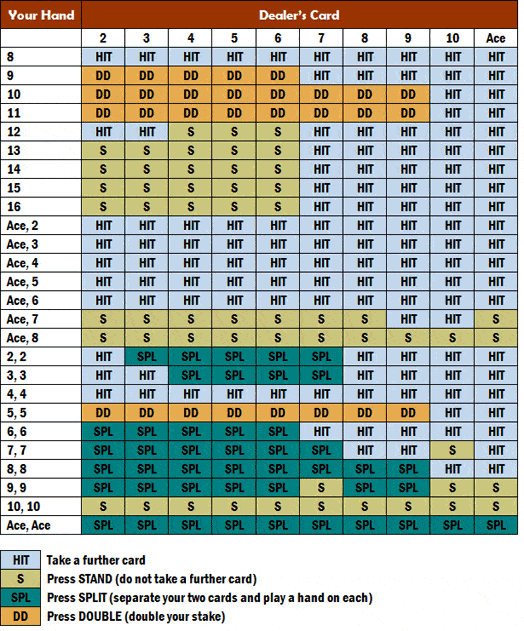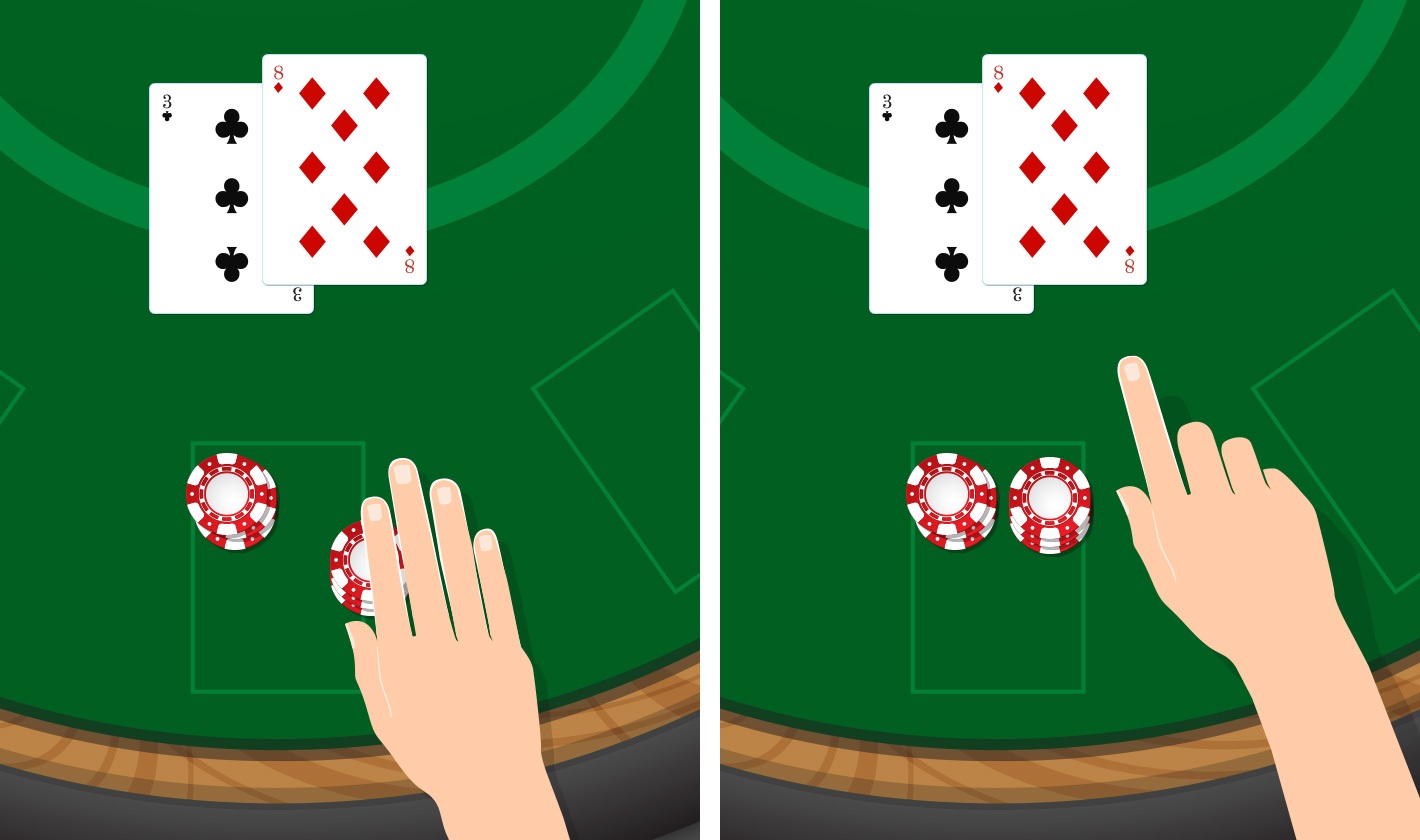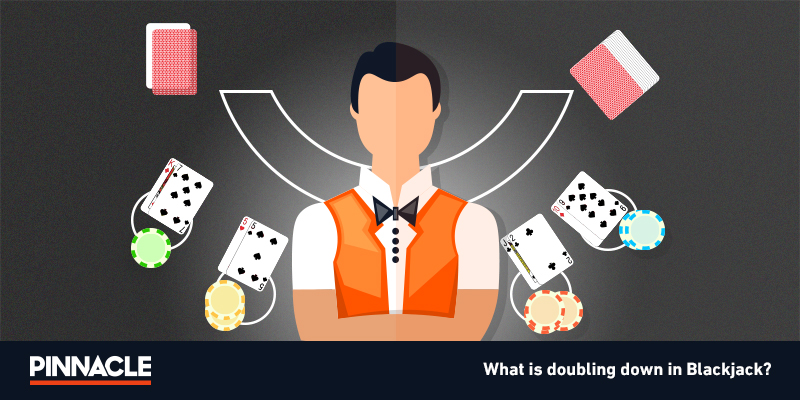Blackjack Double Down For Less
Spanish 21 is a blackjack variant owned by Masque Publishing Inc., a gaming publishing company based in Colorado. Unlicensed, but equivalent, versions may be called Spanish blackjack. In Australia and Malaysia, an unlicensed version of the game, with no dealer hole card and significant rule differences, is played in casinos under the name 'Pontoon'. It was first introduced about 1995.[1]
- You may also double down to an amount less than the initial wager if the casino has this exception to its rules on blackjack decisions. One of the best times to double down is when you have 11 cards or more, and the dealer’s hand is at 6 or lower.
- Double Down: You match the original bet (or double down for less) on any number of cards as long as the total does not exceed 21. Double-down wagering is not permitted when the player has Blackjack, however. You may double down on split hands as well, but certain exceptions apply.
- Ace and 10 after splitting aces is a blackjack (paying 3-2) +0.21%: Player may draw to split aces +0.19%: Double deck +0.19%: Six card Charlie 1 +0.16%: Player may double, double for less, or stand after splitting aces +0.15%: Tied blackjack pays 1-2 +0.11%: Ace and 10 after splitting aces is a blackjack (paying 6-5) +0.11%: Double Down Rescue.
- Doubling down for less is an option at some land-based casinos and possibly certain online blackjack variations. The idea is that you increase your bet for a lower amount than its original value. For example, your starting wager is $10 and then the game gives you the option to double down for $5.
Rules[edit]
Now it's one thing to double for less on a hand where doubling down can't change the outcome, such as with the Ace/6 vs. The outcome won't change on this hand whether you hit or double because there's no card you can catch that will make you want to take a second hit.
Spanish 21 is played on a blackjack table with a custom layout and uses the following rules:
- The game is played with six or eight decks dealt from a shoe, or from a continuous shuffling machine (CSM). Spanish 21 is played with 48-card Spanish decks, although standard French suited 52-card decks are used with the 4 ten-spot cards removed. All cards have the same values as in blackjack.
- The dealer gets a hole card.
- Like traditional blackjack, the dealer hits on 16 and stands on 17. In some venues, the dealer hits on a soft 17 (abbreviated as H17), though most venues have the dealer stand on soft 17 (S17). Hitting soft 17 (H17) negatively impacts the player; that rule increased the house edge by 0.40%.
- Blackjack (a natural total of 21 on the first two cards) always wins, and is always paid 3:2 regardless of whether or not the dealer has a blackjack.
- Insurance is paid 2:1, just like in blackjack, despite the fact that there are four fewer ten-valued cards per deck. As 3 cards in 12 are worth ten, the chance of the dealer getting a blackjack when showing an Ace is only 25%. Therefore, for insurance to be an even bet, it would have to pay 3:1, not 2:1. The house edge on the insurance is 24.7%, one of the worst of any wager in a casino.
- Hitting, standing, and splitting all follow similar rules to blackjack. Doubling after splitting (DAS) is always permitted, and, in most venues, players are allowed to draw as many cards as they wish after splitting aces, or may double down after receiving second or subsequent cards.
- Players can split to a maximum of four hands, even on aces.
- In most venues, if the dealer does not have blackjack, players may surrender, and get half their bet back in exchange for relinquishing the right to play on. This type of surrender is known as a 'late surrender' (LS).
- Players can surrender after doubling (sometimes called forfeit, double-down rescue, or concede). The dealer takes the original bet, and the player retains the double portion of the bet. This is because the player is allowed to double down for less than the original bet.
- Once the initial two-card hands are dealt, if the dealer is showing an Ace or face card, he peeks underneath the hole card to check for a blackjack, before playing actually commences. If he has blackjack, all players automatically lose, unless they also have a blackjack (which, as mentioned above, automatically win 3:2).
- The player may double down on any total and on any number of cards.
- In some casinos, players may double double down, or redouble up to two times after doubling down. For example: The player bets one unit and is dealt 2-3, giving a hand total of 5; the dealer is showing a 6. The player doubles the first time and draws a 3. The hand total is now 8 and the total amount wagered is two units. The player doubles a second time and draws a 3. The hand total is now 11 and the total amount wagered is four units. When the player doubles a third time on 11, the total amount wagered will be eight units. Redoubling is a profoundly player-advantageous rule, when optimally executed.
- A total of 21 always wins for the player. It never pushes against the dealer's 21.
- A five-card 21 pays 3:2, a six-card 21 pays 2:1, and a 21 with seven or more cards pays 3:1. A 21 composed of 6-7-8 or 7-7-7 of mixed suits pays 3:2, of the same suit pays 2:1, and of spades pays 3:1. These bonus payouts apply even if the hand was the result of a split. However, doubling down negates these bonuses.
- A 'super bonus' of $1000 for bets under $25, and $5000 for bets of $25 and over, is paid on a suited 7-7-7 against any dealer 7. All other players at the table receive a $50 'envy bonus'. Splitting or doubling down negates the 'super bonus'.
The removal of the four tens in each deck gives roughly a 2% advantage to the dealer. The liberal rules of Spanish 21, though, do compensate for this. With optimal play, the house edge of a Spanish 21 table is lower than that of a blackjack table with the same rules on hitting or standing on soft 17.
The game also offers an optional 'Match the Dealer' side bet, which compares a player's cards with the dealer's upcard. Matching the rank of the dealer's card pays 4:1 on a six-deck game, and 3:1 on an eight-deck game, while a 'perfect match' of rank and suit pays 9:1 on six decks and 12:1 on eight decks. A player may win on both cards; (e.g. if a player has 8s 8c and the dealer has 8c as an upcard, the player will receive 3:1 on the rank match and 12:1 on the perfect match, paying out a total of 15:1.) While this side bet has a house edge of approximately 3%, significantly higher than the edge of the main game, it is one of the lowest house edges of any blackjack side bet.
House edge[edit]
The following tables list the Spanish 21 house edges for all rule sets found in North America.[2] (The figures were obtained from 10-billion hand simulations and have a standard error of 0.001%. The super bonus is averaged out to a 100:1 payout.) These charts assume that the player is using basic strategy. 'H17' means that the dealer hits soft seventeen, 'S17' means that the dealer stands on soft seventeen.
| Rules | Decks | House Edge |
|---|---|---|
| H17 | 6 | 0.78% |
| 8 | 0.80% | |
| S17 | 6 | 0.37% |
| 8 | 0.38% | |
| H17 with redoubling | 6 | 0.42% |
| 8 | 0.45% |
| Rule Changes | Change in House Edge |
|---|---|
| No surrender (H17) | 0.018% |
| No surrender (S17) | 0.006% |
| No draws on split Aces (H17 or S17) | 0.28% |
| No draws on split Aces (H17 with redoubling) | 0.29% |
| Natural after split pays 3:2 | –0.16% |
Match the Dealer[edit]

Match the Dealer is a side bet offered on most Spanish 21 games. The player wins the side bet if the rank of either or both of their initial two cards matches the rank of the dealer's up card. If the cards match in both rank and suit, the player wins a bigger payout. Some casinos offer a second Match the Dealer bet which wins when either or both of the player's initial two cards match the dealer's hole card. The payouts and the house edge vary depending on the number of decks in play as shown below.
| Number of Decks | Non-Suited Match | Double Non-Suited Match | Suited Match | Suited + Non-Suited Match | Double Suited Match | House Edge |
|---|---|---|---|---|---|---|
| 2 | 4:1 | 8:1 | 15:1 | 19:1 | NA | 3.63% |
| 4 | 4:1 | 8:1 | 10:1 | 14:1 | 20:1 | 3.20% |
| 5 | 3:1 | 6:1 | 13:1 | 16:1 | 26:1 | 3.53% |
| 6 | 4:1 | 8:1 | 9:1 | 13:1 | 18:1 | 3.06% |
| 8 | 3:1 | 6:1 | 12:1 | 15:1 | 24:1 | 2.99% |
References[edit]

- ^Dalton, Michael. 'S ... is for Shuffle - Blackjack Review Network'. Blackjack Review Network.
- ^Reproduced from The Pro's Guide to Spanish 21 and Australian Pontoon (Lulu Publishing, 2008), with permission from the author, Katarina Walker
External links[edit]
In casino blackjack, the rules for doubling and splitting have one key difference. While both of these rules allow a player to increase his wager after the initial cards are dealt, splitting specifically requires the player to match the original bet amount with an equal wager on the second hand, while doubling down has no such restriction. The casino will gladly allow you to “double for less”, by adding an amount less than the original bet in return for drawing only one additional card. That’s not surprising, since doubling for less is never the correct strategy for a player at a regular game. If it is advantageous to double, it’s best to get as much money on the table as possible. Remember, you’re also giving up the ability to draw more than one card to your hand.
While doubling for less is always a mistake in a live game, tournament play is different. In fact, when used properly, doubling for less is a powerful technique for getting an extra edge over your opponents. In this article, we’ll look at two examples when it’s appropriate.
In the article on position, I discussed the importance of position in tournament play, and noted that players to your left are a bigger threat than players to your right. The reason is simple. On most hands, the players to your left get to see your bet and playing decisions before they make their own decisions. As a result, having a second opportunity to change the amount of your wager can be valuable. That means doubling and splitting are more useful than in regular table play.
Example 1: Stealing a shot at the lead
Let’s imagine that you are trailing a player to your left by $50, and you are nearing the end of the round. If you can’t afford to wait until the button passes you to make a move for the lead, doubling or splitting can be your best shot. Let’s say you bet $100, and your opponent matches that bet behind you. The cards are dealt and you have a hard 12, he has a hard 18, and the dealer shows a 4 upcard. Here’s a situation where basic strategy says you should stand. However, it’s also a great opportunity to steal the lead from your opponent. By doubling your 12, you can take the lead if successful. However, since this is generally a poor play, you should double for as little as possible to accomplish your goal. In this case, doubling for $55 or $60 is appropriate.

While this can be a strong play, there are several factors you should consider before pulling the trigger on the double. How many hands are left? How many hands will he be betting behind you? What is the maximum bet, and what are the bankrolls? Perhaps the most critical factor is how damaging a losing swing would be to your chances. If you bust the 12, and the dealer busts behind you, you are now $305 behind. If the max bet is $300, that’s a terrible handicap, and unless the round is nearly over, you should perhaps skip this opportunity and hope for a better shot later. On the other hand, if the max bet is $1000, and you both have plenty of chips, then a $305 deficit is no big deal, and this is probably a great time to take a shot.
Note that the same factors apply to your opponent after you double. If you succeed in drawing a good card to your hand, he may consider doubling his hard 18 behind you. While it’s almost a sure loser, if a negative swing is not a big deal it might be the right play for him.
Example 2: Forcing your opponent to make a choice
Here’s a powerful technique that I’ve never seen mentioned in print before. Though it’s far from unknown among tournament pros, I’ve seen very few players use it, although the situation comes up pretty frequently.
Blackjack Double Down For Less High


Back at the table, you’re still trailing Lefty by $50, but now it’s the last hand. You’ve bet $250, and Lefty matches it. You have an 11, Lefty has a pair of face cards, and the dealer shows an 8. You have a basic strategy double-down, and it is quite apparent that you should double if you want to have any reasonable chance of winning the round. In the last example, we had a poor double-down and wanted to minimize the cost by doubling for less.
This time, with a solid basic strategy double, most players would choose to double for the full amount. That would be a huge mistake! Consider what happens if you draw a poor card on your double. If your double ends up stiff, with a total of less than 17, Lefty can now lock you out of any chance to win. He can split the face cards, stand on any stiff, and you have zero chance of winning the round. It’s over!
To eliminate this possibility, you should double for less. If you double for anything between $55 and $195, you’ve created a difficult choice for your opponent. He can no longer lock you out with a split. If he splits, and the dealer beats both of you, you now advance instead of him. Since he can’t split for less, you force him to choose between “first high” and “first low”. He must decide whether he wants to cover you winning or the dealer winning, since he cannot do both. All this, just because you doubled for less than the full amount.
This tactic works wonders, no matter what the dealer upcard, and almost no matter what you draw on your double-down. Doubling for less is almost always preferable to doubling for the full amount any time your opponent has a pair that they would prefer to split rather than double.
This is a powerful play, and it arises often enough that it deserves a name. Since I’ve never seen it mentioned by other authors, I’ll go out on a limb and christen it “Ken’s Quandary”, with the quandary being your opponent’s, after you double down. Few plays will provoke a stronger grimace from across the table.
Best of luck out there, -Ken-
Double Down Blackjack Pics
For more articles on blackjack tournaments and tournament strategy, you can:
Return to the Blackjack Tournaments Section, or
Move on to the next article The Rule of 2, 4, and 5.